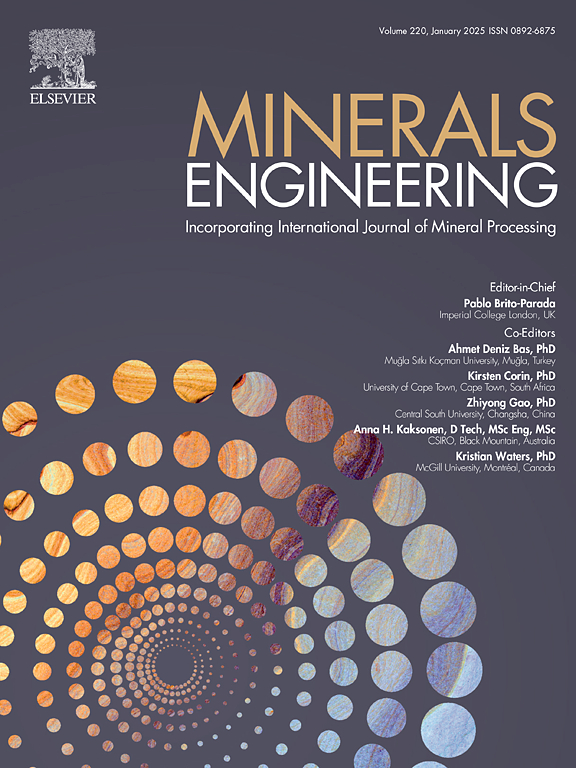Selective depression of pyrochlore and barite using GG/TA combined depressant: Flotation mechanisms and molecular insights
IF 4.9
2区 工程技术
Q1 ENGINEERING, CHEMICAL
引用次数: 0
Abstract
This study presents the first investigation into the application of a combined depressant, Gellan gum (GG)/tannic acid (TA), for the selective flotation separation of pyrochlore and barite, using CaCl2 as an activator and NaOl as a collector. Micro-flotation experiments demonstrated that GG/TA at a 1:1 ratio effectively depressed pyrochlore flotation while maintaining high barite recovery, achieving a pyrochlore recovery of only 0.2 % at a dosage of 6 mg/L. The competitive adsorption mechanism was elucidated through contact angle measurements, zeta potential analysis, Fourier-transform infrared spectroscopy (FT-IR), and X-ray photoelectron spectroscopy (XPS). The results revealed that GG/TA preferentially chemo-synergistic adsorbed onto pyrochlore active sites, forming a hydrophilic barrier that impeded NaOl attachment and thus suppressed flotation. In contrast, GG/TA showed minimal physical adsorption on the barite surface, facilitating NaOl adsorption on barite, thereby promoting its hydrophobicity and enhancing flotation selectivity. XPS analysis further identified GG/TA adsorption primarily at Nb and O sites on pyrochlore, whereas adsorption on barite occurred weakly at Ba and O sites. Additionally, frontier molecular orbital (FMO) theory analysis indicated that the functional groups of GG and TA interact with mineral surfaces, influencing their depression behavior. Based on these findings, an adsorption model for the GG/TA depressant in pyrochlore-barite separation was proposed.

求助全文
约1分钟内获得全文
求助全文
来源期刊

Minerals Engineering
工程技术-工程:化工
CiteScore
8.70
自引率
18.80%
发文量
519
审稿时长
81 days
期刊介绍:
The purpose of the journal is to provide for the rapid publication of topical papers featuring the latest developments in the allied fields of mineral processing and extractive metallurgy. Its wide ranging coverage of research and practical (operating) topics includes physical separation methods, such as comminution, flotation concentration and dewatering, chemical methods such as bio-, hydro-, and electro-metallurgy, analytical techniques, process control, simulation and instrumentation, and mineralogical aspects of processing. Environmental issues, particularly those pertaining to sustainable development, will also be strongly covered.
 求助内容:
求助内容: 应助结果提醒方式:
应助结果提醒方式:


